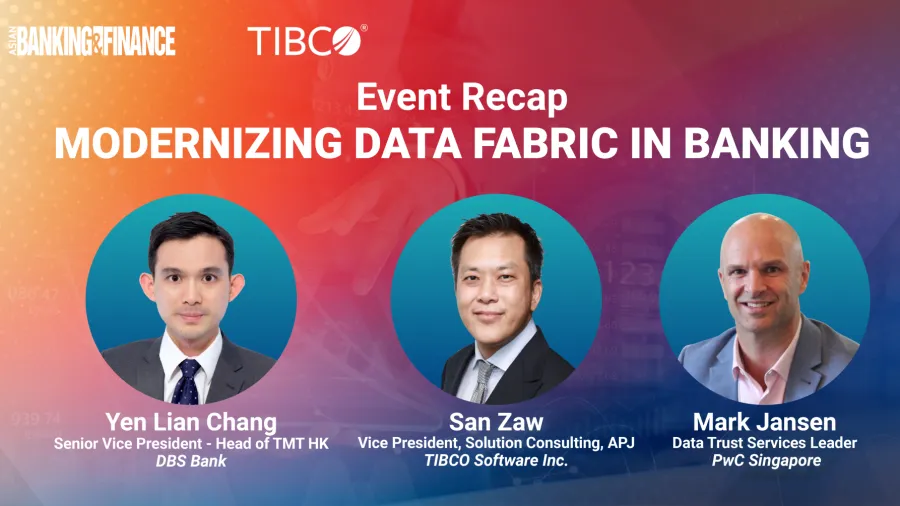
A modernised data fabric is the way to go for financial sector
The right data infrastructure can help banks and insurance firms boost their business operations.
In the era of big data, more and more companies are now leveraging the power of data to help their businesses drive operational efficiency, generate intelligent insights and improve customer experience. Top firms know the value of data and managing it efficiently is the key to business success.
Asian Banking and Finance’s latest webinar “Modernising Data Fabric,” in partnership with global leader in enterprise data TIBCO, shared how this can be done and emphasised to banks and insurance firms the importance of having intelligently curated data.
TIBCO Vice President, Solution Consulting, APJ, San Zaw, one of the speakers for the virtual event, discussed where banks need to go with their data considerations and how a modernised data fabric can keep their business competitive.
Unlocking the full potential of data
Zaw highlighted that people now have been consuming digital services all the time, and that the line between what is business, a daily task, or entertainment is blurring. Banks and financial institutions have also changed along, shifting their focus to a customer-centric view.
He said that this can impact the industry in two ways. Firstly, it is now expected to have the same level of customer intimacy, relevance, and engagement in the sector’s digital touchpoints, which includes digital banking and other financial services. Secondly, customers are bound to become more conscious about their digital lifestyle journeys, which cut across multiple partner ecosystems.
As such, the concern now for FSI is not about how many application programming interfaces (API) they roll out, but how relevant and personalised their offerings are to the partner ecosystem.
“So this whole focus on having a customer intimate, personalised API brings our attention squarely back to data, because APIs by themselves are just business logic, it doesn't do anything particularly groundbreaking. But having the right data, training the right AI/ML models, and deploying these AI/ML models in each touchpoint at the APIs is making all the difference,” Zaw said.
Today, there is a seismic shift of data science moving towards production, deploying data at scale at the digital touchpoints. Zaw mentioned that this shift is putting a lot of pressure on having an agile data fabric.
Speed of data and having it automated is the main driver of having an agile data fabric, as it should look directly into the entire data delivery pipeline. At the same time, getting the right data is also relevant to ensure accuracy and avoid bias in the process.
Zaw also mentioned that the data fabric pipeline works with other functional pieces, like a data catalogue, and data governance layer.
“Most banks, if not all already have these data catalogues and data governance layers in any shape or form. The data fabric will definitely work and augment with those. It can also help replace silos that are having difficulty working with other data components if it's needed.”
Addressing data challenges
In the same virtual event, PwC Singapore’s Data Trust Services Leader Mark Jansen provided some insights regarding the frequent data challenges that are being faced by banks and financial institutions, as well as how to address them.
Jansen mentioned that banks need to look at the whole ecosystem that supports the data.
“So in doing that, where do I think banks are starting to shift better is where they're getting much more capability around the data management solution in particular, that means they get high quality data, they get a better source of information and clearer on how they manage that data,” he said.
Across this, he mentioned the use of data lakes and virtualisation. Access to data, putting permissions and privacy rules to enable the analytics, and using the data to drive outcomes are some of the main considerations to ensure these are met in the process of modernising data fabrics.
“I think we're starting to see merging potential use of AI into credit and underwriting this has its own challenges because it impacts various ratios of the bank,” Jansen added. According to him, the use of AI and ML data in banking whilst having great benefits also needs to be used carefully as ethical considerations and the ability to explain the impact on not just customers but also key financial metrics can make this complex.
Using streaming platform Netflix as an example,the impact of poor recommendations to a consumer is minimal, though it would impact potential revenue as consumers may switch to alternate streaming platforms. This is unlike banking where AI outcomes that do directly impact consumers livelihood, for example access to finance.
“If you're starting to underwrite using AI, and you get your underwriting models, your credit models wrong, actually, that can have consequences not just the bank's ratios [and other financial metrics], but more importantly, [it] actually impacts [customers] both access to banking."
What this means is that Banks and FIs more broadly need strong data programs that manage not just the risks around the use of AI, but also more broadly consider data management and data architecture as some of the key backbones to good data programs. Ultimately, the ability to have high quality data that can be clearly attributed and sourced is part of the key to good data outcomes (other areas include strong model management, bias assessment etc, this is covered in more depth under the MAS FEAT principles).
Ensuring efficiency in operations with the right data infrastructure
DBS Bank’s Senior Vice President - Head of TMT HK Yen Lian Chang also provided some insights on how banks can utilise data fabrics, especially from a client’s perspective.
He said that more clients have requested turning around things much smarter and faster.
“I think the issues now we're sticking with is, actually a lot of those onboarding processes, capturing KYC information, and things of that sort are still conducted pretty manually. And I see a lot of manual interventions,” Chang said.
Clients, however, are still looking for efficiency in the process, despite a lot of progress being made in the digital ecosystem.
“Whilst we are working on potential co-lending models, or even alternative lending base model where we rely on calculations, API connections, connecting to warehouse collateral levels and things like that, I think a lot of hiccups is actually sticks around with how you can sort of mass on board all these hundreds and thousands of merchants in a short span of time,” he said.
Chang also mentioned that he is fully aware of the fact that in the Hong Kong market, the regulatory requirements or the players are a bit more cognizant, if they should standardise the process, or the audit from the regulators.
“Are we able to justify the standardised process and still able to sort of cope with the regulatory requirements? Which, of course, I think it's possible, it's just how you make those,” he said.



















 Advertise
Advertise










